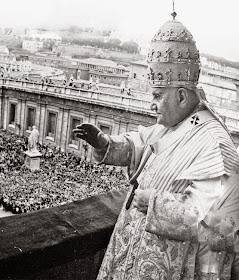This post concerns Father Richard Hinkley, of the Archdiocese of Galveston-Houston (Texas, USA), who was ordained to the Sacred Priesthood in the Co-Cathedral of the Sacred Heart on 7th June.
Father Hinkley commissioned vestments made in an early mediaeval style for his First Holy Mass. The chasuble (shewn adjacent), fully in the conical form, was sewn from handmade dupion silk of a cream colour and was ornamented very simply with braids in the colours of royal blue, red, straw and ivory. The vestments were lined in taffeta of a muted yellow colour. A matching cope was also made for Father Hinkley.
Please pray for Father Hinkley and for all newly-ordained priests.
Please click on the images for an enlarged view.
Enquiries: stbede62@gmail.com
 |
| Cope made for Father Hinkley. |
 |
| Father Hinkley ordained by Cardinal DiNardio. |
 |
| The noble interior of the Houston Co-Cathedral, looking towards the west window. |
 |
| The Sacred Heart Co-Cathedral, built only very recently, against the Houston skyline. |












